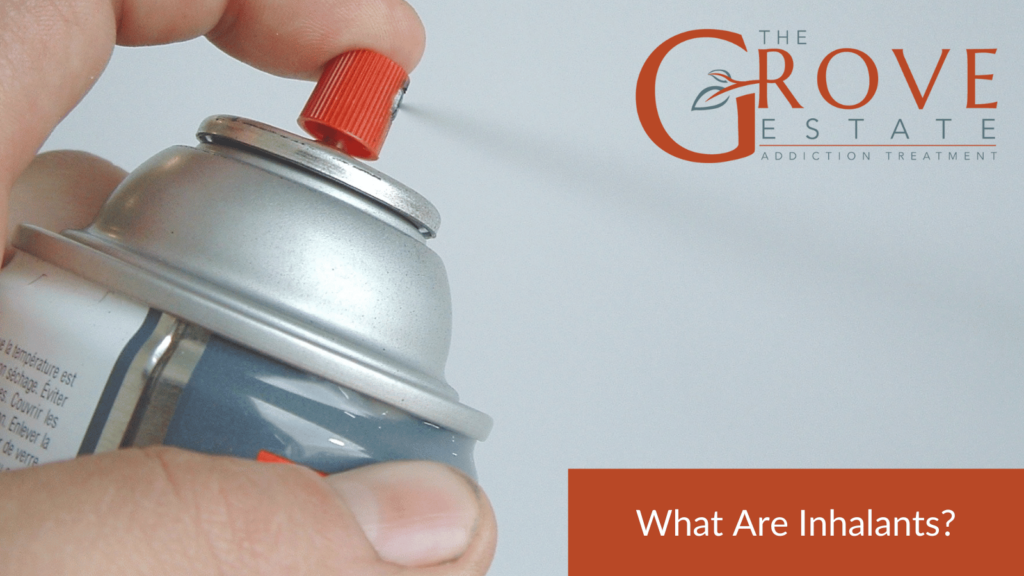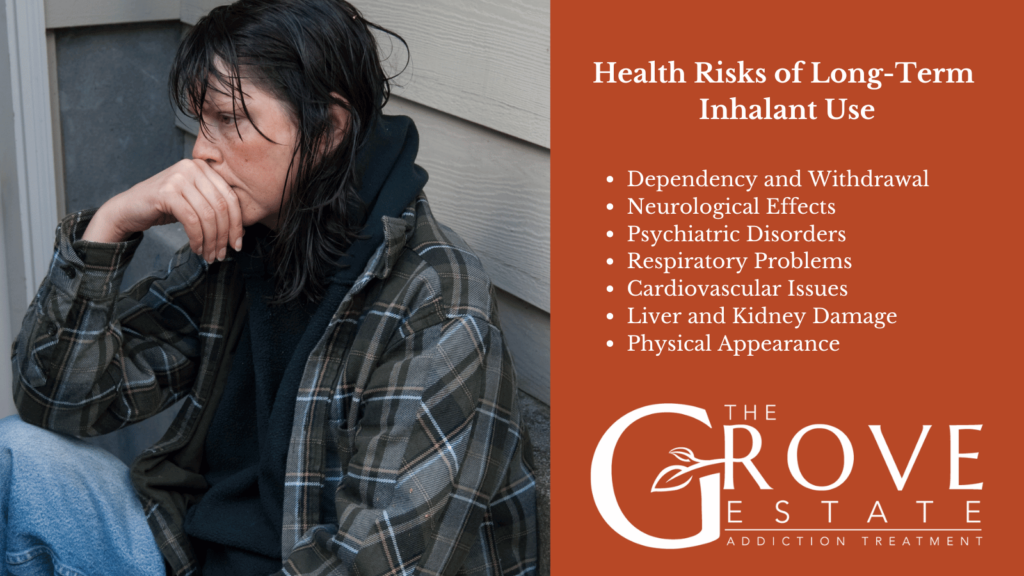Inhalant addiction, commonly referred to as “huffing,” is a critical yet frequently overlooked public health concern that presents considerable risks. This type of substance abuse involves the inhalation of vapors from everyday household products, resulting in both immediate and long-term adverse effects. It’s important to recognize the signs, symptoms, and available treatment options to effectively intervene and offer support.
Physically, inhalant use can cause dizziness, headaches, nausea, and coordination problems. Psychologically, long-term use leads to mood disorders, anxiety, and, in severe cases, hallucinations or delusions. According to the National Institute of Drug Abuse, 0.8%, or about 2.2 million people, aged 12 or older, reported using inhalants in the past 12 months. Despite its potential for addiction and severe health consequences, inhalant abuse is less acknowledged compared to other drugs.
Treatment for inhalant addiction typically involves a comprehensive approach, beginning with detoxification to manage physical withdrawal in a secure environment. This is followed by behavioral therapies such as Cognitive Behavioral Therapy (CBT) to address the root causes of addiction. Family therapy and support groups play crucial roles in providing a supportive network, essential for long-term recovery and relapse prevention. Awareness and education about the risks of inhalant abuse are key to preventing and addressing this dangerous behavior effectively.

What Are Inhalants?
Inhalants are substances whose chemical vapors can be inhaled to produce psychoactive effects. These substances are often found in common household and industrial products. The allure of inhalants is primarily due to their accessibility and the rapid onset of their intoxicating effects, which can mimic those of alcohol.
Inhalants are categorized into four main groups based on their physical forms and the common products they are found in:
- Solvents: These are liquid substances that vaporize at room temperatures. Common examples include paint thinners, dry cleaning fluids, gasoline, lighter fluid, and various glues. These solvents are typically found in products such as cleaning fluids, nail polish removers, and marker pens.
- Aerosols: These are substances found in spray cans that contain propellants and solvents. Products such as spray paints, hair or deodorant sprays, cooking oil sprays, and fabric protector sprays fall into this category.
- Gasses: These can be found in household or commercial products as well as in medical anesthetics. Examples include butane lighters, propane tanks, whipped cream aerosols (whippets), and medical gasses like ether, chloroform, halothane, and nitrous oxide (often referred to as laughing gas).
- Nitrites: Often considered a separate class due to their different mechanism of action, these include substances like amyl, butyl, and isobutyl nitrite. Commonly known as “poppers” or “snappers,” nitrites are used primarily as sexual enhancers or muscle relaxants and are found in products marketed as room odorizers or leather cleaners.
How Are Inhalants Used?
Inhalants are typically used through a few common methods that exploit their volatile nature to achieve rapid psychoactive effects. Here’s a list outlining the common methods of inhalant use:
| Method | Description | Appeal to Younger Demographics |
| Sniffing | Involves directly inhaling the vapors from the container by placing the nose close to the opening. | Simple and quick, requiring minimal preparation, which appeals to younger users looking for an accessible way to experiment. |
| Snorting | Similar to sniffing, but involves a stronger, quicker inhalation to intensify the effect. | Offers a fast and intense experience, which can be tempting to those seeking a strong and rapid high. |
| Bagging | Involves spraying or placing the inhalant into a plastic or paper bag and then breathing in the vapors from the bag. | The method allows the vapors to accumulate and concentrate, providing a more potent effect, which can be more appealing for its efficiency. |
| Huffing | Consists of soaking a rag with an inhalant and pressing it to the mouth or nose. | Provides a sustained release of vapors, which may appeal to those looking for prolonged effects. |
The appeal of inhalants, especially to younger demographics, largely stems from the easy accessibility and perceived lower risk compared to other substances. Inhalants are often readily available at home or in common products around the house, making them one of the first accessible psychoactive substances to young people. Furthermore, the rapid onset of effects, which can include euphoria and hallucinations, adds to their allure, despite the significant health risks associated.

What are the Short-term Effects of Inhalant Use?
Inhalant abuse can lead to a range of severe physical and psychological effects. The allure of these substances lies in their rapid onset of psychoactive effects, but this can also lead to significant health risks. Here is a list of the short-term effects of inhalants:
- Euphoria: Similar to alcohol intoxication, users may experience a sense of well-being and happiness.
- Dizziness and Lightheadedness: Users often feel off-balance and dizzy.
- Impaired Judgment and Motor Coordination: Like other intoxicants, inhalants can reduce an individual’s ability to make decisions and control their movements.
- Hallucinations and Delusions: Some users experience visual and auditory hallucinations.
- Sudden Sniffing Death Syndrome: This is a fatal risk even on the first use, where the heart begins to beat rapidly and erratically, leading to cardiac arrest.
How Can I Recognize the Signs of Inhalant Addiction?
Recognizing the signs of inhalant addiction is important for early intervention and effective treatment. Common physical indicators include a noticeable smell of chemicals on the breath or clothes and stains from substances like paint around the nose, mouth, or hands. Individuals may also show a decline in personal care, appearing increasingly unkempt. Physical symptoms such as dizziness, poor coordination, and an unsteady gait are often evident. Changes in appetite leading to significant weight loss, along with frequent nausea or vomiting, are also warning signs.
Behavioral changes are another indicator. Individuals experience abrupt mood swings, irritability, or signs of depression. A marked retreat from social interactions, loss of interest in previously enjoyed activities, and a drop in performance at school or work are typical. Secretive or deceptive behaviors aimed at concealing substance use, especially among teenagers, include a noticeable decrease in school attendance or grades. The presence of items like rags, bags, or empty containers commonly associated with inhalant use points directly to abuse.

What are the Health Risks of Long-Term Inhalant Use?
There are many severe health risks and symptoms that arise from prolonged inhalant use, affecting various bodily systems significantly.
Dependency and Withdrawal
Prolonged inhalant use can lead to dependency, characterized by withdrawal symptoms such as headaches, muscle cramps, agitation, and severe mood swings when usage ceases.
Neurological Effects
Chronic inhalation can severely damage the brain and nervous system, resulting in memory loss, reduced cognitive function, impaired coordination, and tremors. Permanent brain damage is possible, which may cause lasting cognitive impairments and an increased risk of neurological disorders.
Psychiatric Disorders
Long-term inhalant use can also lead to or worsen psychiatric disorders, including anxiety, depression, and psychotic episodes, which may persist even after stopping the use of inhalants.
Respiratory Problems
Inhalants can cause significant harm to the respiratory system, leading to respiratory distress, diminished lung capacity, and higher risks of bronchitis or pneumonia. In severe cases, respiratory failure can occur, which can be fatal.
Cardiovascular Issues
The misuse of inhalants stresses the cardiovascular system, manifesting as irregular heartbeats and palpitations.
Liver and Kidney Damage
Inhalants contain toxic chemicals that can damage the liver and kidneys, impeding their ability to process toxins and potentially leading to organ failure.
Physical Appearance
Chronic users often show noticeable changes in physical appearance, such as weight loss, skin conditions, and an overall appearance of poor health.
What are the Treatment Options for Inhalant Addiction?
Treating inhalant addiction involves a comprehensive strategy due to its complex physical and psychological dimensions. Here’s an overview of the primary treatment modalities:
Medical Detoxification
This is the initial step in recovery, focusing on medically supervised withdrawal to safely manage the acute physical symptoms of detoxification. This phase is critical, as withdrawal from inhalants can pose severe risks, including life-threatening conditions.
Rehabilitation Programs
Both inpatient and outpatient rehab programs provide structured treatment settings. Inpatient rehab includes around-the-clock care and support, making it suitable for those with severe addiction. Outpatient rehab allows individuals to participate in treatment sessions while living at home, offering flexibility as they maintain daily responsibilities.
Behavioral Therapies
Cognitive Behavioral Therapy (CBT) is a key component of addiction treatment, helping individuals recognize and modify harmful behaviors and thought patterns. Additional therapies like motivational interviewing and family therapy also play vital roles in supporting recovery.
Support Groups
Peer support groups such as Narcotics Anonymous (NA) offer ongoing encouragement, enabling individuals to share their experiences and gain support from others facing similar challenges.
Dual Diagnosis Treatment
Often, individuals with inhalant addiction also contend with co-occurring mental health disorders. Dual diagnosis treatments are designed to address both the addiction and any accompanying mental health issues concurrently, which is essential for effective recovery.

How Can We Support Recovery, Aftercare, and Prevent Inhalant Abuse?
Recovering from inhalant addiction involves not only addressing the immediate challenges of detoxification and withdrawal but also implementing long-term strategies to prevent relapse. A strong support network is essential in this journey, offering both emotional and practical support that enhances the chances of sustained recovery.
The recovery process from inhalant addiction requires continuous effort and support. Aftercare programs are crucial as they provide ongoing therapy and support group meetings, which help individuals maintain their sobriety. The focus is on developing personal accountability, managing triggers, and building a healthy lifestyle that supports long-term sobriety.
Prevention strategies are key in reducing the initiation and continuation of inhalant abuse, especially among at-risk populations such as adolescents. Parents, educators, and community leaders play critical roles in this effort. Effective prevention includes educating these groups about the dangers of inhalants, recognizing signs of abuse, and fostering environments that promote healthy choices and behaviors.
The role of education cannot be overstated. It empowers individuals with the knowledge to make informed decisions and provides them with the tools to recognize and address inhalant abuse before it escalates into addiction. Awareness campaigns and school-based programs are effective in disseminating information about the risks associated with inhalant use and the importance of seeking help for substance abuse issues.
What are whippits?
Whippits refer to small cartridges filled with nitrous oxide, commonly used in whipped cream dispensers. They are often abused for their psychoactive effects, which can produce feelings of euphoria and relaxation when inhaled.
Are there any legal consequences for abusing inhalants?
While inhalants themselves are legal when used for their intended purposes, such as household cleaning or in medical settings, the abuse of these substances can lead to legal consequences. Possession of certain inhalants with the intent to abuse can be illegal, and driving or engaging in other activities while under the influence can lead to charges such as public intoxication or DUI.
Can inhalant abuse be detected in a drug test?
Inhalant abuse is not typically detected in standard drug tests because the volatile substances evaporate quickly from the body. However, some specialized testing techniques can detect traces of these substances or their byproducts in blood or urine shortly after use.
What should I do if someone is intoxicated by inhalants?
If someone is showing signs of inhalant intoxication—such as dizziness, confusion, or agitation—it’s important to ensure their safety, prevent them from operating vehicles or machinery, and seek medical attention immediately. Inhalant intoxication can rapidly lead to severe health issues, including respiratory distress and cardiac effects.
How does inhalant addiction affect mental health?
Inhalant use can severely impact mental health, leading to conditions such as mood disorders, anxiety, and in severe cases, hallucinations or delusional behavior. The toxic chemicals in inhalants can alter brain chemistry and may cause permanent damage to the central nervous system.
Addressing these mental health issues is critical in the treatment process. Therapeutic approaches like group counseling offer peer support and professional guidance, which can help mitigate the psychological effects of inhalant abuse and aid in the recovery of mental wellness.
Are there specific risks associated with different types of inhalants?
Yes, different types of inhalants pose varying risks due to their chemical compositions. Solvents and aerosols, commonly abused for their rapid psychoactive effects, can cause sudden sniffing death syndrome due to heart failure. Gases, including medical anesthetics like nitrous oxide, may cause severe neurological damage, while nitrites, often used as sexual enhancers, primarily impact the cardiovascular and immune systems.
For those struggling with substance abuse, including less common dependencies such as Zetran addiction, it’s crucial to understand the specific health risks associated with each type of inhalant. Knowledge about these risks can inform treatment choices and recovery strategies.

Share This Post



